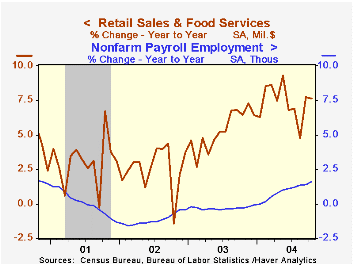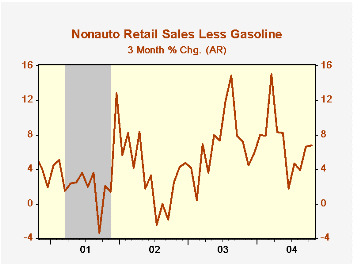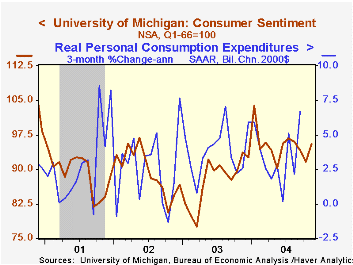 Global| Nov 12 2004
Global| Nov 12 2004U.S. Retail Sales Gain
by:Tom Moeller
|in:Economy in Brief
Summary
US retail sales rose an expected 0.2% (7.6% y/y) last month, the gain held back by lower auto sales. September sales were revised up slightly. During the last twenty years there has been a 60% correlation between the y/y change in [...]

US retail sales rose an expected 0.2% (7.6% y/y) last month, the gain held back by lower auto sales. September sales were revised up slightly. During the last twenty years there has been a 60% correlation between the y/y change in retail sales and the change in payroll employment.
Motor vehicle & parts dealers sales fell 2.2% after a 4.3% jump in September as unit sales of light vehicles fell 3.1% m/m.
Sales excluding motor vehicles surged 0.9%, nearly double the Consensus expectation, following an upwardly revised 0.8% jump in September.
Discretionary spending was led by a 3.0% (6.7% y/y) surge in clothing & accessory store sales on top of a 1.0% September increase.Sales at general merchandise stores added 0.9% (7.4% y/y) to the 1.3% September spike but sales of furniture/home furnishings & electronics/appliances rose just 0.1% (4.1% y/y) which left sales down slightly over the last three months. 
Sales at gasoline service stations surged 4.3% (23.8% y/y) as the retail price of gasoline rose 6.9% m/m to $2.00/gallon. Nonauto retail sales less gasoline rose 0.5% (6.9% y/y).
Building materials, garden equipment & supply dealers' sales slid 1.1% (9.5% y/y) following a like gain in September.
| Oct | Sept | Y/Y | 2003 | 2002 | 2001 | |
|---|---|---|---|---|---|---|
| Retail Sales & Food Services | 0.2% | 1.6% | 7.6% | 5.4% | 2.5% | 3.1% |
| Excluding Autos | 0.9% | 0.8% | 8.5% | 5.2% | 3.2% | 3.1% |
by Tom Moeller November 12, 2004

The University of Michigan's mid-month November consumer sentiment reading of 95.5 rose 4.1% m/m from October, adding to the improvement during October's second half. Consensus expectations had been for a reading of 93.0.
During the last ten years there has been a 75% correlation between the level of consumer sentiment and the y/y change in real PCE.
The consumer expectations index jumped 5.8% m/m (0.7% y/y) while the current economic conditions index rose 2.1% (3.6% y/y).
The University of Michigan survey is not seasonally adjusted.The mid-month survey is based on telephone interviews with 250 households nationwide on personal finances and business and buying conditions. The survey is expanded to a total of 500 interviews at month end.
"Consumer Sentiment and the Media" from the Federal Reserve Bank of San Francisco can be found here.
| University of Michigan | Oct | Sept | Y/Y | 2003 | 2002 | 2001 |
|---|---|---|---|---|---|---|
| Consumer Sentiment | 91.7 | 94.2 | 2.3% | 87.6 | 89.6 | 89.2 |
| Current Conditions | 104.0 | 103.7 | 4.1% | 97.2 | 97.5 | 100.1 |
| Consumer Expectations | 83.8 | 88.0 | 1.0% | 81.4 | 84.6 | 82.3 |
Tom Moeller
AuthorMore in Author Profile »Prior to joining Haver Analytics in 2000, Mr. Moeller worked as the Economist at Chancellor Capital Management from 1985 to 1999. There, he developed comprehensive economic forecasts and interpreted economic data for equity and fixed income portfolio managers. Also at Chancellor, Mr. Moeller worked as an equity analyst and was responsible for researching and rating companies in the economically sensitive automobile and housing industries for investment in Chancellor’s equity portfolio. Prior to joining Chancellor, Mr. Moeller was an Economist at Citibank from 1979 to 1984. He also analyzed pricing behavior in the metals industry for the Council on Wage and Price Stability in Washington, D.C. In 1999, Mr. Moeller received the award for most accurate forecast from the Forecasters' Club of New York. From 1990 to 1992 he was President of the New York Association for Business Economists. Mr. Moeller earned an M.B.A. in Finance from Fordham University, where he graduated in 1987. He holds a Bachelor of Arts in Economics from George Washington University.






